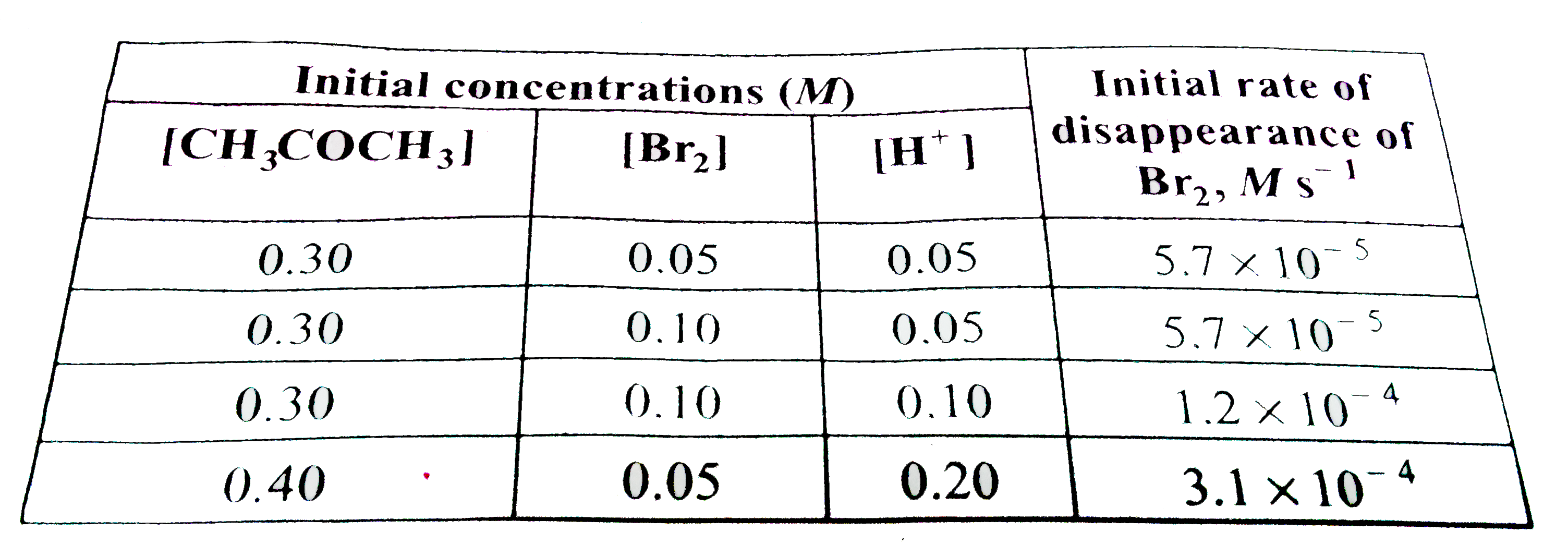The bromination of acetone that occurs in acid solution is represented by
CH3COCH3(aq.)+Br2(aq.)→CH3COCH2Br(aq.)+H+(aq.)+Br−(aq.)
These kinetic data were obtained for given reaction concentrations :

Based on these data, rate equations is :
Rate=k[CH3COCH3][Br2][H+]2
Rate=k[CH3COCH3][Br2][H+]
Rate=k[CH3COCH3[H+]
Rate=k[CH3COCH3[Br2]
Rate=k[CH3COCH3]α[Br2]β[H+]γ
5.7×10−5=k[[0.30]α[0.05]β[0.05]γ .....(i)
5.7×10−5=k[0.30]α[0.10]β[0.05]γ .....(ii)
1.2×10−4=k[0.30]α[0.10]β[0.10]γ .....(iii)
3.1×10−4=k[0.40]α[0.05]β[0.20]γ .....(iv)
Divinding eq. (i), be eq. (ii)
1=[12]β,i.e.,β=0
Dividing eq. (ii) by eq. (ii),
1=[12]γ,i.e.,γ=1
Dividing eq (i) by eq. (iv)
5.7×10−53.1×10−4=[34]α×[14]1
Thus, rate law will be
rate k=[CH3COCH3]1[H+]1
Topper's Solved these Questions
- CHEMICAL KINETICSBook:OP TANDONChapter:CHEMICAL KINETICSExercise:PRACTICE PROBLEMS
Explore 70 Videos
- CHEMICAL KINETICSBook:OP TANDONChapter:CHEMICAL KINETICSExercise:OBJECTIVE QUESTIONS (LEVEL-A)
Explore 192 Videos
- CHEMICAL KINETICSBook:OP TANDONChapter:CHEMICAL KINETICSExercise:LINKED COMPRESHENSION TYPE QUESTIONS ( SECTION-VI)
Explore 4 Videos
- CARBOXYLIC ACIDS AND THEIR DERIVATIVESBook:OP TANDONChapter:CARBOXYLIC ACIDS AND THEIR DERIVATIVESExercise:Integer
Explore 4 Videos
- Chemical Thermodynamics and ThermochemistryBook:OP TANDONChapter:Chemical Thermodynamics and ThermochemistryExercise:Self Assessment (Integer type).
Explore 3 Videos
Similar Questions
The bromination of acetone that occurs in acid solution is represented by
CH3COCH3(aq.)+Br2(aq.)→CH3COCH2Br(aq.)+H+(aq.)+Br−(aq.)
These kinetic data were obtained for given reaction concentration
Initial concentration
Initial concentrationInitial rate ofdisappearance[CH3COCH3][Br2][H+]of Br20.300.050.055.0×10−50.300.100.55.0×10−50.300.100.101.0×10−40.900.050.103.0×10−4
Based on these data, order of reaction will be -
View SolutionThe bromination of acetone which occurs in acid solution is represented by the equation:
CH3COCH3(aq)+Br2(aq)→CH3COCH2Br(aq)+H+(aq)+Br−1(aq)
The following kinetic data was obtained for the given reaction concentration:

Initial rates of disappearance of of Br2(Ms−1
5.7×10−5,5.7×10−5
1.2×10−4,3.1×10−4
Based on these data, the rate equation is:
View Solution
Knowledge Check
The bromination of acetone that occurs in acid solution is represented by this equation
CH3COCH3(aq)+Br2(aq)→CH3COCH2Br(aq)+H+(aq)+Br−(aq)
These kinetic data were obtained for given reaction concentrations .Initial concentrations , M
[CH3COCH3][Br2][H+]0.300.050.050.300.100.050.300.100.100.400.050.20
Initial rate , disappearance of Br2,Ms−1A5.7×10−5B5.7×10−5C1.2×10−4D3.1×10−4The bromination of acetone that occurs in acid solution is represented by this equation.
CH3COCH3(aq)+Br2(aq)→
CH3COCH2Br(aq)+H+(aq)+Br(aq)
These kinetic data were obtained for given reaction concentrations.
Initial concentration, M
[CH2COCH3][Br2][H+](Initail rate) (disappearance of Br2)0.300.050.051.5×10−50.300.100.055.7×10−50.300.100.101.2×10−40.400.50.203.1×10−4Arate =k[CH3COCH3][Br2]Brate =k[CH3COCH3][Br2][H+]2Crate =k[CH3COCH3][Br2][H+]Drate =k[CH3COCH3][H+]The bromination of acetone that occurs in acid solution is represented by
CH3COCH3(aq.)+Br2(aq.)→CH3COCH2Br(aq.)+H+(aq.)+Br−(aq.)
These kinetic data were obtained for given reaction concentrations :

Based on these data, rate equations is :ARate =k[CH3COCH3][Br2][H+]BRate k=[CH3COCH3][H+]CRate O ||[CH3−C−CH3][Br2]DRate =k[CH3COCH3][Br2][H+]2
The bromination of acetone that occurs in acid solution is represented by this equation.
CH3COCH3(aq)+Br2(aq)→CH3COCH2Br(aq)+H+(aq)+Br−(aq)
These kinetic data were obtained for given reaction concentrations.
[CH3COCH3][Br2][H+]rate of disappearance of Br2,(Ms−1) 0.300.050.05 5.7×10−5 0.300.100.05 5.7×10−5 0.300.100.10 1.2×10−4 0.400.050.20 3.1×10−4
Based on these data, the rate equation is
View SolutionThe Bronsted acids in the reversible reaction are HCO−3(aq.)+OH−(aq.)CO2−3(aq.)+H2O
View SolutionFor the reaction :
(CH3)3CBr(aq)+OH−(aq)→(CH3)3COH(aq)+Br−(aq)
it is found that halving the concentration of (CH3)3CBr causes the reaction rate to be halved but halving the concentration of OH− has no effect on the rate. What is the rate law?
View SolutionConsider the reaction:
H2SO3(aq)+Sn4+(aq)+H2O(l)→Sn2+(aq)+HSO−4(aq)+3H+(aq)
Which of the following statements is correct?
View SolutionAssertion :- Bromide ion is serving as a reducing agent in the reaction
2MnO−4(aq.)+Br−(aq.)+H2O→2MnO2(aq.)+BrO−3(aq.)+2OH−(aq.)
Reason :- Oxidation number of Br increases from −1 to +5
View Solution

